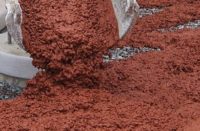Maximizing the performance of decorative concrete requires a deep understanding of both the materials involved and the innovative technologies that enhance their properties. Although concrete is a remarkably versatile and durable building material, it presents several inherent challenges that must be addressed in order to ensure optimal workability, strength and longevity.
Whether working with stamped patios, polished floors or intricate overlays, the need to balance aesthetic appeal with structural integrity is a constant challenge. This is where admixtures come into the equation. These advanced chemical formulations offer precise control over the concrete’s behavior, allowing for improved placement, superior surface finishes and extended durability.
The Role of Admixtures in Decorative Concrete
Admixtures modify concrete at a chemical level, enabling contractors to achieve performance characteristics that would otherwise be difficult to control. Workability is one of the most immediate benefits. Complex formwork, detailed stamping patterns and thin overlays demand a mix that flows easily yet holds its shape without excessive bleeding or segregation. Water-reducing admixtures, such as plasticizers and superplasticizers, enhance the flowability of concrete without increasing the water-to-cement ratio. This ultimately preserves concrete strength while making placement easier.
Set-controlling admixtures, including retarders, are particularly useful for decorative work in hot weather conditions. These materials help to extend the working time, which allows contractors to execute detailed stamping, texturing or polishing without the concrete setting prematurely. Viscosity-modifying admixtures contribute to mix stability, ensuring color consistency in integrally pigmented concrete and preventing unwanted water migration that could affect the finish.
Another crucial benefit of admixtures is their ability to enhance bonding and adhesion in decorative overlays and resurfacing applications. Polymer-modified admixtures improve the flexibility and adhesion of thin overlays, ensuring that they do not delaminate or crack over time. This is particularly important for applications such as micro-toppings, self-leveling overlays and decorative resurfacing systems, where the bond strength between new and existing surfaces is critical for long-term durability.
Enhancing Durability & Protecting Against Environmental Challenges
Beyond placement and finishing, admixtures also play an important role in enhancing the durability of concrete. Decorative concrete installations—particularly those exposed to outdoor conditions—must withstand a range of environmental stresses. Freeze-thaw cycles, moisture infiltration and shrinkage-induced cracking are some of the most common concerns. Air-entraining admixtures provide resistance to freeze-thaw damage by introducing microscopic air pockets into the mix, which allows expanding water to move without creating internal pressure that leads to cracking or spalling.
Shrinkage-reducing admixtures minimize moisture loss during curing, significantly reducing the likelihood of unsightly cracks that could compromise both appearance and longevity. In fast-track construction scenarios, accelerators can expedite the setting process and promote early strength development, reducing downtime and allowing for quicker use of decorative surfaces.
With decorative concrete applications, maintaining color integrity and achieving a uniform, aesthetically pleasing surface is crucial. Admixtures that are specifically designed for color stability help to distribute pigments evenly, which prevents streaking or mottling. Efflorescence-control admixtures can also minimize the movement of soluble salts to the surface, eliminating the white, chalky deposits that can detract from stained or integrally colored concrete.
Incorporating pozzolanic materials, such as silica fume or metakaolin, also refines the concrete’s microstructure, enhancing both surface smoothness and color vibrancy. These factors are especially important for high-end decorative finishes, where even minor imperfections can be noticeable.
In addition to improving visual appeal, admixtures can be used to extend the lifespan of decorative concrete. Corrosion-inhibiting admixtures are particularly useful for reinforced decorative elements, such as concrete countertops with embedded steel reinforcement or architectural panels with structural support. These admixtures help mitigate chloride-induced corrosion, which can lead to surface discoloration, cracking and premature failure in exposed environments.
Achieving the Right Mix Design Through Collaboration
Achieving the right mix design is not a one-size-fits-all process. Successful decorative concrete projects require close collaboration between contractors, ready-mix suppliers and admixture specialists. The selection of cement type, aggregate size and admixture combination must be carefully evaluated to ensure compatibility. Some admixtures, particularly high-range water reducers, can alter workability in unexpected ways if not properly balanced with the mix’s other components.
Trial batching and laboratory testing are essential steps in fine-tuning a concrete mix prior to full-scale production. By conducting preliminary tests, contractors can assess factors such as slump retention, air content and setting time. This allows them to make any necessary adjustments to the concrete mix in order to achieve the desired performance. Field trials further validate the mix in real-world conditions, accounting for variables such as temperature, humidity and placement techniques.
Concrete performance is inherently influenced by climatic conditions, making admixture selection an important factor in adapting to environmental challenges. For example, retarders prevent premature setting in warmer climates, which allows for extended finishing time. On the other hand, accelerators compensate for slower hydration rates in colder conditions, ensuring timely strength development. These considerations are particularly relevant for outdoor decorative installations, where exposure to temperature fluctuations can impact the quality of the final product.
A mix that performs well in one season may require modifications when placed under different weather conditions. Mixes designed for summer placement, for instance, may need adjustments to account for winter’s slower hydration rates, while those used in cold climates may require different admixture dosages to maintain workability. These variations highlight the importance of ongoing quality control, testing and mix design adaptability to ensure consistent results in any environment.
Admixtures as a Smart Investment in Performance & Sustainability
Although cost is always a consideration in decorative concrete work, investing in high-quality admixtures can yield significant long-term savings. While some contractors may initially hesitate due to the perceived cost increase, the reality is that admixtures reduce the need for costly repairs and maintenance over time. Shrinkage-reducing admixtures, for example, prevent cracks that could otherwise necessitate resurfacing or patching. Air-entraining admixtures protect against freeze-thaw damage, extending the lifespan of exterior decorative concrete surfaces.
High-performance water reducers allow for lower cement content while maintaining strength, which reduces material costs and minimizes the environmental footprint of a project. The role of admixtures in sustainable construction is also gaining popularity. As environmental regulations become more stringent, admixture technologies are evolving to support sustainability goals. Water-reducing admixtures optimize mix efficiency, leading to lower cement consumption and reduced CO₂ emissions.
The use of supplementary cementitious materials, such as fly ash and slag, enhances durability while repurposing industrial byproducts that would otherwise contribute to waste. Some admixtures even contain recycled content, aligning with LEED certification requirements and other green building standards. As the industry continues to move toward more sustainable practices, admixtures will remain a key tool for balancing performance with environmental responsibility.
The Future of Admixtures in Decorative Concrete
The future of decorative concrete belongs to those who innovate. By incorporating high-performance admixtures, contractors can reduce material waste, enhance efficiency, and deliver results that meet both functional and aesthetic demands. As sustainability regulations tighten and client expectations rise, admixture technology is the key to meeting and exceeding these demands. Now is the time to step ahead, adopt innovative solutions and push the boundaries of what decorative concrete can achieve.
The question is no longer IF admixtures should be part of your mix, but HOW you can maximize their potential to create concrete surfaces that stand out, last longer and perform better than ever before.


















